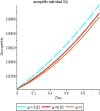Mathematical analysis of fractional-order Caputo's derivative of coronavirus disease model via Laplace Adomian decomposition method
- PMID: 36532840
- PMCID: PMC9734552
- DOI: 10.1186/s43088-022-00326-9
Mathematical analysis of fractional-order Caputo's derivative of coronavirus disease model via Laplace Adomian decomposition method
Abstract
Background: The world's survival ability has been threatened by the COVID-19 outbreak. The possibility of the virus reemerging in the future should not be disregarded, even if it has been confined to certain areas of the world after wreaking such havoc. This is because it is impossible to prove that the virus has been totally eliminated. This research attempts to investigate the spread and control of the COVID-19 virus in Nigeria using the Caputo fractional order derivative in a proposed model.
Results: We proposed a competent nine-compartment model of Corona virus infection. It starts by demonstrating that the model is epidemiologically sound in terms of solution existence and uniqueness. The basic reproduction threshold R0 was determined using the next-generation matrix technique. We applied the Laplace-Adomian decomposition method to the fractional-order Caputo's derivative model of the Corona virus disease to produce the approximate solution of the model analytically. The obtained results, in the form of an infinite series, were simulated using the MAPLE 18 package to investigate the effect of fractional order derivative on the dynamics of COVID-19 transmission in the model and shed light on methods of eradication. The graphical interpretations of the simulation process were shown and discussed accordingly.
Conclusions: The study reveals the effect of the Caputo fractional order derivative in the transmission dynamics of the disease. Individual recovery was found to be greatest at an integer order, which represents the full implementation of other factors such as treatment, vaccination, and disease transmission reduction. Hence, we advised that researchers, government officials, and health care workers make use of the findings of this study to provide ways in which disease transmission will be reduced to a minimum to stop the prevalence of COVID-19 by applying the findings of this study.
© The Author(s) 2022.
Conflict of interest statement
Competing interestsThe authors declare that they have no competing interests.
Figures












References
-
- Lauer SA, Grantz KH, Bi Q, Jones FK, Zheng Q, Meredith HR, Azman AS, Reich NG, Lessler J. The incubation period of coronavirus disease 2019 (COVID-19) from publicly reported confirmed cases: estimation and application. Ann Internal Med. 2020;172(9):577–582. doi: 10.7326/M20-0504. - DOI - PMC - PubMed
LinkOut - more resources
Full Text Sources
